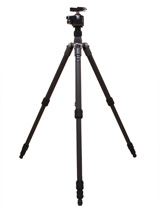 When you first start shopping for a tripod, you might be a little shocked by the price range: there’s some for $20 and then there’s others for hundreds of dollars.
When you first start shopping for a tripod, you might be a little shocked by the price range: there’s some for $20 and then there’s others for hundreds of dollars.
So, what’s the deal with that huge price range? How could something so simple cost so much? Three metal legs for $500?
I’ll admit that when I first got a digital SLR, I went ahead and got one of those generic $20 tripods. I tried to use that thing once, and after watching my camera slowly slide down after I kept locking it in, I decided to invest in a good tripod.
The good part is that you don’t necessarily need to spend $500 on a tripod. There are some very good ones for about $150, and they’re monumentally better than those generic tripods.
Here are two of the biggest benefits you’ll experience with a “good” tripod:
#1 – More stability
The job of the tripod is to keep your camera still, so it’s important to have a stable tripod. Stability means that once you lock in your camera on the head of the tripod, then your camera completely stops moving. How much your camera slides and/or shakes after locking it in will vary with the quality of the tripod and head.
If you’re already using a pretty good tripod, and you still notice a lot of sliding and/or shaking after you lock in your camera, then make sure your tripod and head can handle the amount of weight you’re putting on it (multiply the weight of your camera and lens by three, and this number should be less than the load capacity of the tripod). And, if you’re using a long lens, you might need a tripod collar for the lens, since the center of gravity shifts sometimes with those longer lenses (generally anything longer than 200mm needs a collar).
#2 – Quick to set up
A good tripod will also be designed so it’s very easy and quick to set up. This is really important in nature photography, because many of those special moments don’t last too long.
Before you invest a lot of money in a tripod, I’d recommend trying out a few different designs at a camera store. See what design works best for you. For example, some people really like tripod legs with latches, while others prefer the legs that you can just screw loose.
Try one out for yourself
If these benefits still aren’t enough to convince you, then I’d highly recommend trying out a few tripods at a camera store, or borrowing one from a friend. I still remember how amazed I was after trying out a Manfrotto tripod for the first time… and then being amazed even more after trying out a Gitzo tripod and Really Right Stuff ballhead.
Recommendations
There are a lot of good tripods out there, but here are a few I can personally recommend:
- Manfrotto 190XPROB with a 496RC2 head (great affordable tripod)
- Gitzo 1542T with a RRS BH-30 head (very lightweight) – Read my review!
- Gitzo 2531 with a RRS BH-40 head (very stable)
Maybe it’s not too late to ask Santa for one of these? 😉
What did I miss?
If there’s another benefit that you’ve found with using a good tripod, or if you have any good tripod stories, please tell us about it by leaving a comment below. Thanks! 🙂
Get more great tips in our free weekly newsletter.
 About the Author: Steve Berardi is a naturalist, photographer, software engineer, and founder of PhotoNaturalist. You can usually find him hiking in the beautiful mountains and deserts of southern California.
About the Author: Steve Berardi is a naturalist, photographer, software engineer, and founder of PhotoNaturalist. You can usually find him hiking in the beautiful mountains and deserts of southern California.

I have found that the fewer knobs and extra unnecessary features a tripod has, the more likely I am to use it. All of those things ad weight as well.
Yeah, I used my $25 Walmart tripod for about a week. When I got my Manfrotto setup, I was amazed how much sharper my photos were. My first tripod had allowed a nano-inch of movement during exposure, which is of course too much! If you’re going Manfrotto, though, I do recommend something above the setup that you have listed here.
I have an older Manfrotto 3021BPro wit a 488RC2 head that I have been using for several years. (I think this may have been replaced by a different model number now.) It has served me well, but I’m ready for a good carbon fiber tripod to save some weight. One thing I love about using a tripod is that it slows me down, and makes me take my time setting up a shot.
When I first started out, I had one of those cheap $20 tripods from a big box store and it was such a pain in the butt to use that it just wasn’t worth it, but I kept it and still have it. I actually use it more now than I did when I first got it. It makes for a pretty handy stand to mount my speedlite on. Just last week I was going through my parents basement and found another one of those cheep tripods. (This one makes my cheap one look like a pro model!) So know I have two flash stands. 🙂 So if you did buy one of those cheap tripods, you may want to hang onto it and use it to mount a flash, or hold a reflector or something like that.
Steve, I have several tripods; but when I travel I want something really light and small. The important thing is to have a good tripod head. I have gotten along very well with a SLIK Sprint Pro GM, but only after I replaced the cheap head with a Giottos MH 1302. It has been quite satisfactory for my Canon 7D and 60D cameras except in strong wind.
A less expensive version of the Gitzo is Feisol. I added a leveling base to my Feisol and have found it to be a wonderful addition. The point about stability cannot be underestimated! Stability and the leveling base have made my panoramas come out better than ever, with no losses due to not being level!! Spend the bucks on good hardware. The payback is instantaneous!
I too was looking for a tripod that was both stable and light weight. I invested in 3 Legged Thing’s carbon fiber Eric model. This tripod meets both criteria and folds into a very small package as well. I have used it with both my 7D and 5D MKII with a Really Right Stuff bracket attached. Only issue was waiting for either distributor (B&H, Adorama) to get them back in stock.
To me the most important thing about a tripod bsides rigidity, is to free your hands and mind of the camera so you can concentrate on the subject, angle and height.
My personal choice is Manfroto 055CX3. Three sections gives more stability than 4 section style. I prefer the flip leg-locks over the twist leg-locks. A good tripod is worth the price in the long run. But to complete the package you also need a good ball head.
I have 2 Gitzos, an older metal, small one that I used for years until I purchased a med format (6×7) camera and needed a more stable tripod. I purchased a Gitzo with carbon fiber legs and a ball head. have had it for 10+ years, I always use a tripod when shooting.
The point is a good investment in equipment can last 30-40 years with proper care.
I, unfortunately, still have my old $60 cheapo and EVERY TIME I am out using it, I curse myself for not getting a better tripod. My photos are not sharp and the camera moves when locked it….esp when I am doing a portrait mode image. I have to have the camera a bit above level, because it will drop a couple of millimetres from the movement! Grrrr
Thanks for the short list of suggested tripods….and the other suggestions from the viewers! 🙂
I went from $20 cheapo tripod to monopod to somewhat better but heavy used $50 tripod to Gitzo carbon fiber with Acratech GV2 Ballhead in about three years. Wow, what a difference. The ballhead gives me gimbal-like flexibility but is very stable and the Acratech company quickly replaced a broken level for free. I hike long distances with a fussy back so the carbon fiber has made a big difference – I was able to buy my Gitzo on Craig’s List and it was been wonderful. While trying to photograph the unique bands on a beautiful California mountain kingsnake (to identify it as an individual from any future kingsnakes I find), my hands were full so I set the kingsnake on the tripod and found another wonderful use of the Gitzo as seen here: http://dipperanch.blogspot.com/2012/05/cheerful-disposition.html
I’ve had two different types of tripods over the years. One with screw out legs, the other with the flip latch legs. Let me tell you for speed and reliability there’s no comparison when it comes to setting up in a hurry. I live in an area where sand is prevelant. Once your tripod gets wet, or gets sand in the grooves of the legs that screw loose it’ll take you months to get the sand out of the grooves, if ever. By the time you get your tripod legs down and set up your wilflife, or other subjects like a full moon has already come up from the horizon and you’ve missed the shot. Spend a little bit more and get the tripod that you can get the legs out with ease. Just pop loose the latch, legs fall out on their own, and ta-da……you’re set up and ready to go. You’ll never be sorry.
I just picked up a deal at Adorama and got a carbon fiber Vanguard 253CB with a small ball head. It’s light, very stable and handles around 18 lbs. I’ve just ordered a gimble head (BK-45) for it when using longer lenses, but for my D300 and a 70-300 the tripod is stable as a rock. The tripod was marked down from $370 to $150 for both the tripod and head on Black Friday. Next is a Nikkor 300mm F4 and a teleconverter.
I’ve had tripods with both screw legs and latches, while the latches may seem a quick mechanism, one walk through brush and you’ll find those latches to be vine magnets, they’ll tangle up on every vine with a meter radius, not worth it if you plan to bush wack.
Pretty good informational piece for new/beginner photographers and a lot of good comments from folks. I’d like to second the notion that there are some fine tripods and heads out there not made by the big names like Gitzo, RR Stuff, Manfrotto, etc. They can, in my opinion having used them, be just as good. Feisol was mentioned by JIm Van Hoy and I’ll put a plug in for Induro. I sold my Gitzo tripod and purchased the same size Induro and an Induro compact ballhead and still had money left over.